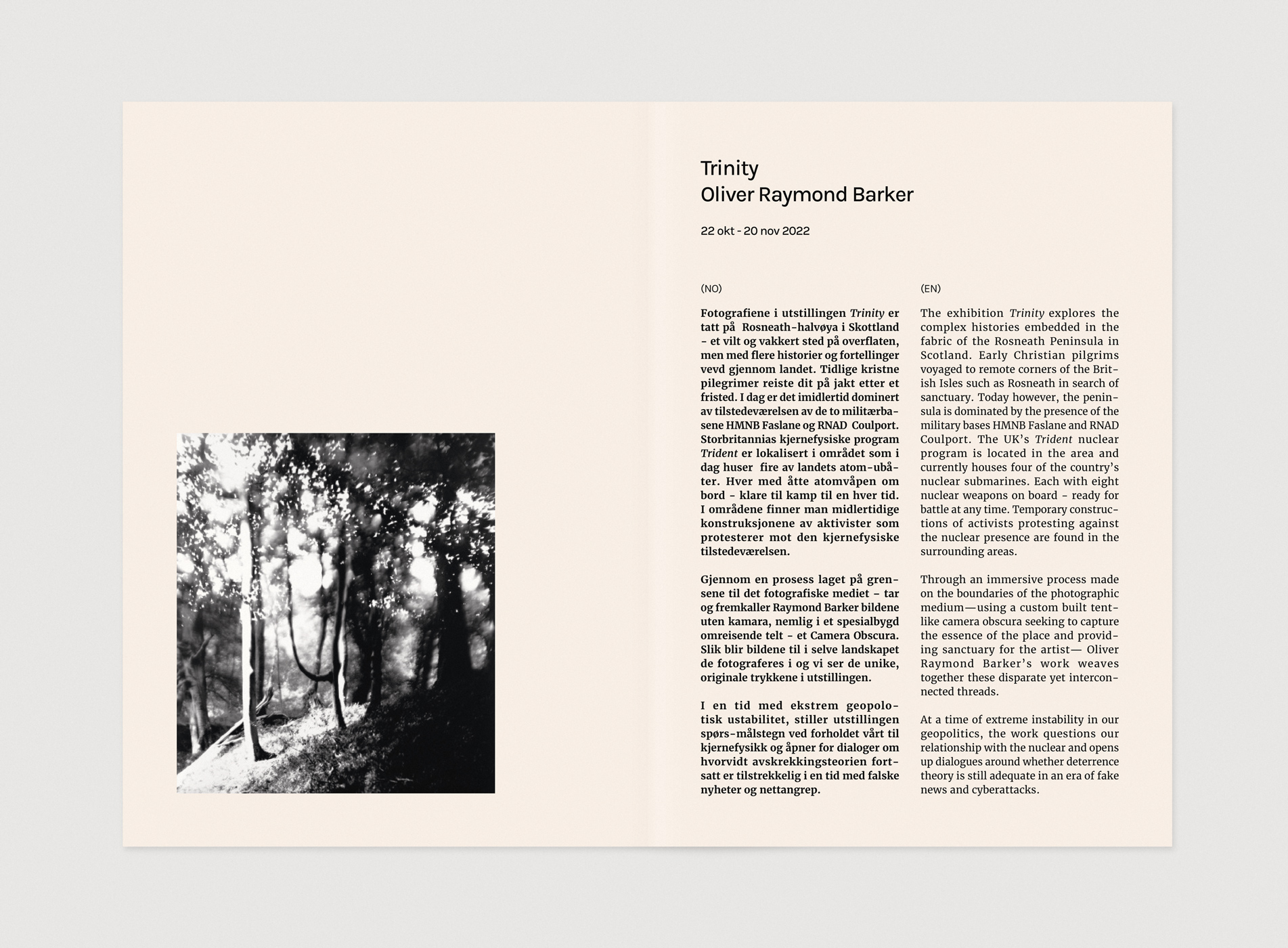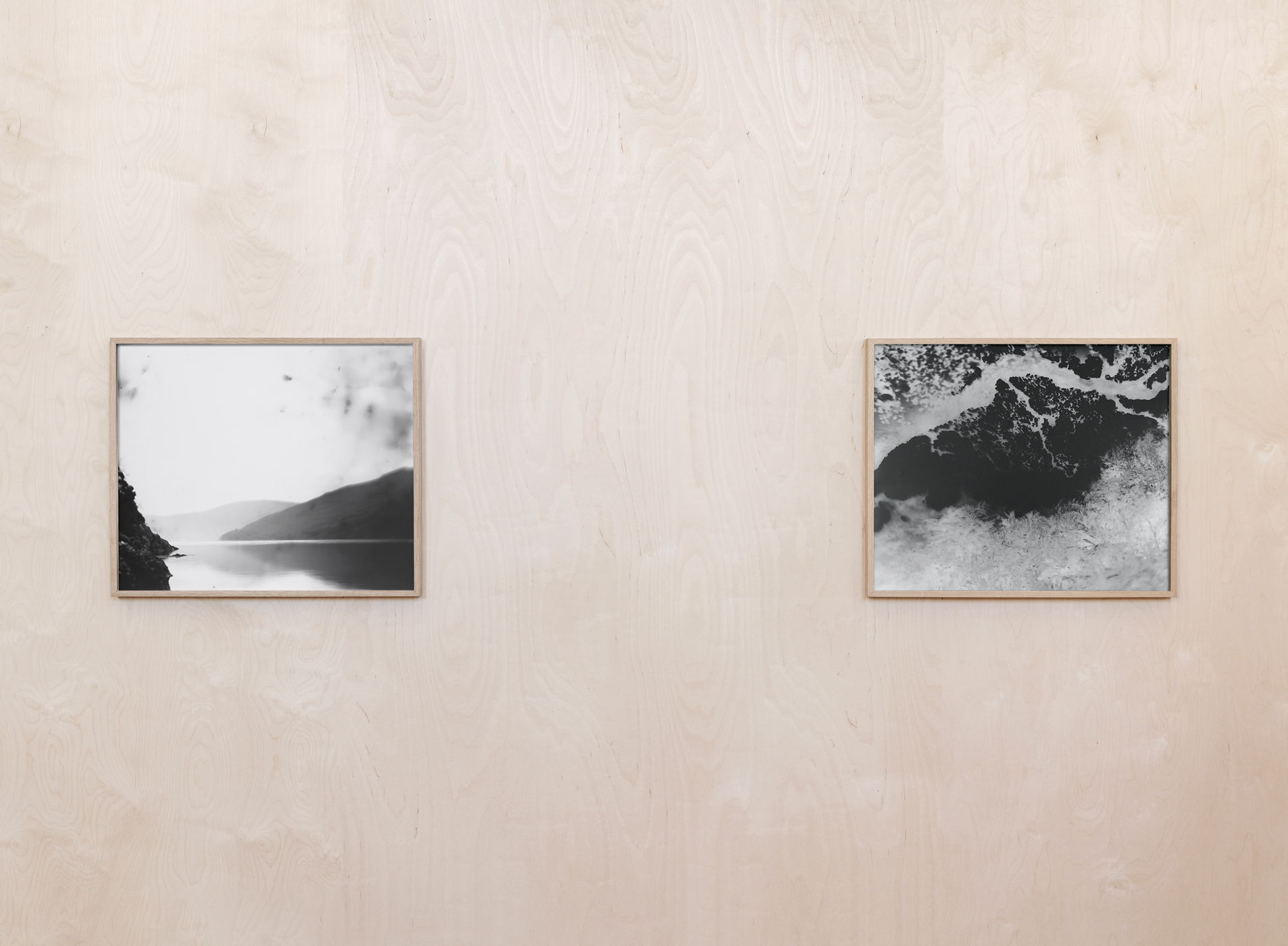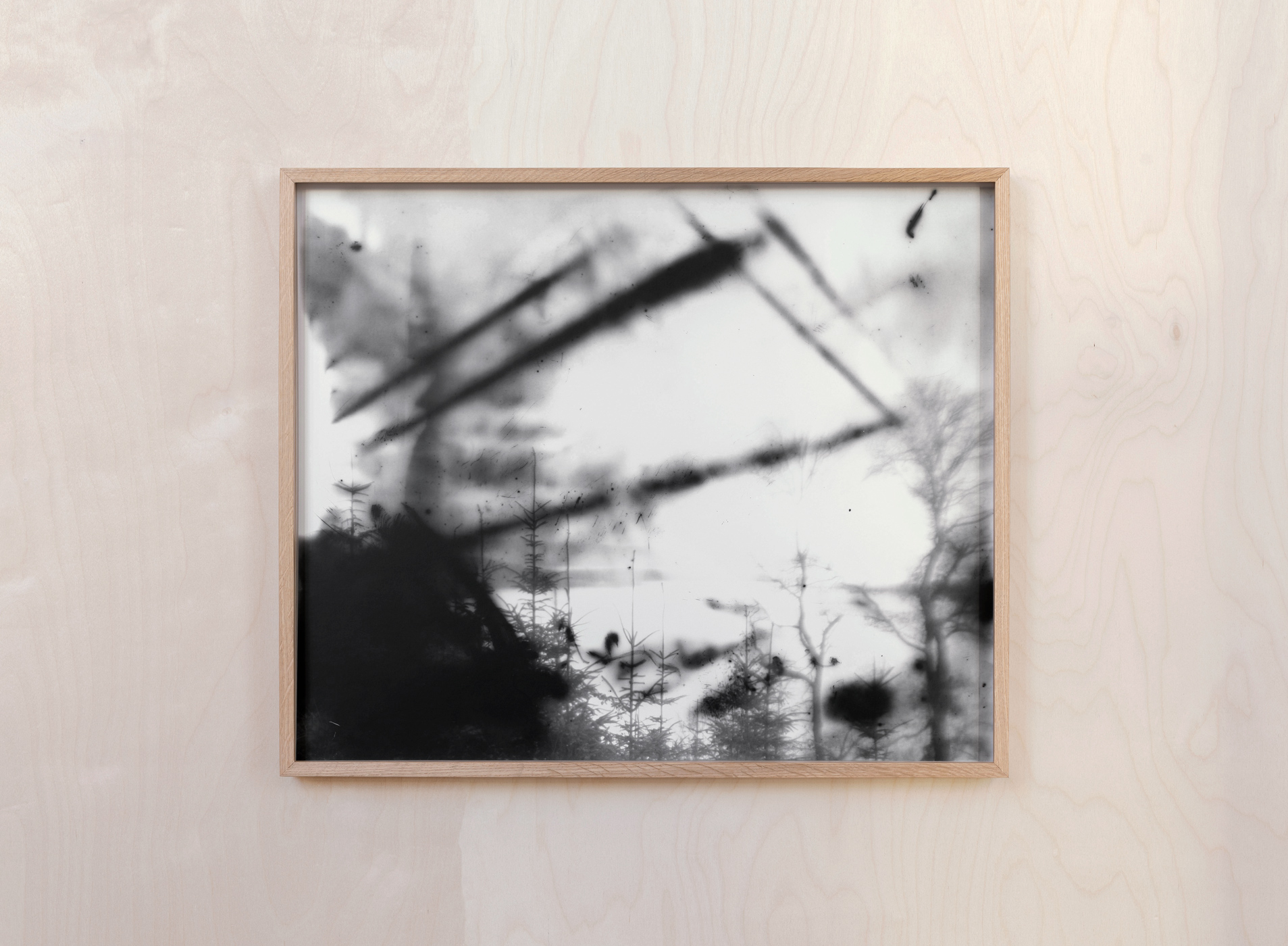Promontory of the Sanctuary
by Chris Littlewood
Exhibition text for Oliver Raymond Barker, Trinity
NŌUA, Bodø, Norway, 2022
by Chris Littlewood
Exhibition text for Oliver Raymond Barker, Trinity
NŌUA, Bodø, Norway, 2022






Stretching across two archipelagos, with over 150 islands, 20 estuaries and thousands of lochs and tidal inlets, the topography of Scotland's west coast is so heavily indented that it appears to splinter and dissolve into the North Atlantic. Seemingly composed of land and water in equal measure, it is hard to imagine a wilder place in Britain or Ireland. In his The Wild Places, nature writer Robert Macfarlane considers the origin story of the peregrini – Celtic Christian monks of the fifth and sixth centuries who journeyed to such places – as a waymark for his own peregrinations in search of wildness. Summoning these early travellers, he describes how "Monks, anchorites, solitaries and other devout itinerants began to travel in their thousands to the bays, forests, promontories, mountain-tops and islands of the Atlantic Litoral." Leaving home without saying goodbye, never to return, the peregrini forsook inhabited places where every feature was already mapped and named. They sought a life of hardship and contemplation, where isolation was a prerequisite for their devotion to Christ. As Macfarlane eloquently expresses: "their travels to these wild places reflected their longing to achieve correspondence between belief and place, between inner and outer landscapes."1
One such wild place was found on the peninsula now named Rosneath. Flanked to the west by Loch Long, to the east by Gare Loch and to the south by the Firth of Clyde, this promontory delineates a three-pronged confluence between waterways. It became the ultimate resting place for Saint Modan, who dwelled and worshipped there as a hermit – in time inspiring pilgrimages of healing to its wells and chapels to be built in his name. Whilst remote, it would have been attractive not only for its seclusion but also its navigability; so much surrounded by water that it was characterised as an island in ancient records.2 Together with wooded glens and grassy knolls, the combination of expanse and enclosure provided the ideal setting to gain spiritual enlightenment. To trace the etymology of Rosneath's name reveals various readings. One Gaelic version applies most readily here: "Rossneveth"3, meaning promontory of the sanctuary. Rooted within its very name, the idea of sheltering persists, whilst evidence of worship and burial linked to Saint Modan remains embedded within its tangible heritage.
Other layers are a testament to an entirely different kind of energy, albeit still connected with the notion of shelter. Dominating the present-day landscape, defensive military architecture on both sides of the peninsula is all-pervasive. Perimeter fencing, hi-tech fortifications and sodium lighting exude a sense of paranoia and control. Harboured on the northern shore of Gare Loch, Faslane naval base is home to Trident: four nuclear-powered submarines designed for carrying ballistic missiles with nuclear warheads. To the west, at the Coulport naval base, the nuclear warheads are stored inside reinforced concrete bunkers. Making up what could be considered the most contentious site in the UK, the munitions on constant rotation in these waters carry a terrifyingly destructive force. Writing extensively about the UK's nuclear deterrent in 2006, James Buchan explains how each missile can carry twelve nuclear warheads into space, dropping each on a different target with one hundred kilotons of explosive force. "In this Armageddon of the imagination, a single British submarine at Faslane could obliterate 1,500 Hiroshimas"4, he exclaims.
Evolving from a sacred pilgrimage site to one of western Europe's most heavily militarised districts, Rosneath resembles a theatre set where contradicting social imaginaries have played out. Somehow bridging this gap, for the past forty years, activists connected with resistance against the military installations have taken part in non-violent direct actions. Part of a global anti-nuclear movement, they passionately oppose the political ideologies the sites represent. With its makeshift dwellings, the nearby Peace Wood Camp has provided refuge for waves of itinerant activists. Among them was Nick Hunt, whose words intersperse the photographs in this exhibition. Interweaving the tales of Saint Modan, a nuclear submarine, and his own experience at Faslane, Hunt's text is partly factual, partly mythical. Strands of narrative are interlaced in a way that seems fluid. They appear and disappear, submerge and surface again. In this hybrid story, Saint Modan – or rather his spirit – wanders the shoreline, passing activists as they return from an encounter with "that shadow in the Water". The submarine, always dark, always ominous, is described elsewhere as a "monstrous mass" whose "brutal, sleek intelligence seems evolved and not designed."5
Adding to the rich lineage of pilgrimages and the subsequent nature writing and memoirs this landscape has inspired, visual artist Oliver Raymond Barker has contributed to this legacy. Setting off for the Cove Arts Centre in 2018 with a camera obscura in his backpack, he used elements from Rosneath's disparate histories as a framework to build Trinity around. Traversing the peninsula, he sought a kind of communion with the landscape, ritually setting up his tent and equipment. A process he likens to a conversation with an old friend. By modifying the tent with a simple aperture at its apex, the artist allows light to pour down through a primitive periscope onto a sheet of photographic paper, reacting with the silver-halide emulsion to expose an image. The structure becomes both a camera-body and a sanctuary for the artist's body. The light – or its absence – as it bounces off the surrounding environment envelopes both.
Suppose photography is the effect of light and time rendered on a substrate. In that case, camera obscuras and camera-less techniques such as photograms are arguably its purest form. Not even film grain comes between a subject and its representation. While this might offer experimental possibilities for some artists in studio settings, what distinguishes Raymond Barker's technique is the transportable nature of his setup. Enabling him to roam freely and respond to shifting nuances, this mode of practice embraces a considerable element of happenstance. Combined with the artist's intuitive reading of a landscape, it allows for moments of total immersion in a scene. As a result, this might be as close as photography gets to an unmediated conversation with the natural world. We often talk about photography in terms of taking or capturing. However, in the case of Trinity, it feels closer to infusing or distilling. If so, this might support the artist's invocation as he seeks to convey the "essence of place".
Camera-less photography often doesn't require the outside world as a subject, focusing more on the qualities of filtered light or direct alchemic manipulation of photographic papers. As the title for a 2015 exhibition at the Getty Museum in LA suggests, the primary focus of this genre is "Light, Paper, Process"6. In that show, seven contemporary American artists demonstrate what the exhibition's curator Virginia Heckert describes as an infatuation with obsolete darkroom materials. Often going to great lengths in sourcing expired papers and chemicals. Collectively they are defined by Heckert in terms of their "willingness to embrace accident and chance and to see delayed results". Arising from the push away from conventional photography and its dependency on informational content, abstraction is their predominant language. It doesn't mean that works of this nature don't have anything to say about the world outside the studio window. By eschewing today's prevalent digital technologies, they represent a comment on the expectation of, if not an obsession with, ultra-realism within the medium at large.
Britain has also produced artists seeking to engage with these fundamental questions. Shadowcatchers, which Raymond Barker considers a key reference point, was a 2011 exhibition highlighting camera-less work at the V&A Museum in London. It was recognised by Harriet Riches for its emphasis on mysterious and somewhat mystical qualities, symbolism, and the fragments and figments of dreams and the subconscious7. In an introductory text published in the Trinity book, Shadowcatchers curator Martin Barnes echoes this sentiment, describing how Raymond Barker's image-making deals as much with the invisible as the visible. For Barnes, the primal quality of the images gives "the impression of an eye opening from slumber onto a world that is not yet fully formed, a realm that is intuited rather than understood."8 Trinity achieves this through the marrying, if not melting together of its visual themes: the embracing of what might usually be seen as faults: light leaks and uneven chemistry; lengthy exposures registering ghostly movement; and the disorientation of inverted and mirrored variations. Not to mention the spiritual yet somewhat dark underlying layers of its subject matter. That said, there's a different quality to the images that is difficult to condense in such definitive terms - an unexplainable fifth element.
As an example, Cove Park Canopy, silver gelatin negative reads as both representational and abstract – almost in equal measure. Readable as a bracken-clad slope, the foreground anchors the image. But only just. The darkened top half, where the canopy and sky should be, loosens its resemblance to our understanding of the physical world. Thus flipping the image into an otherworldly dimension. The effect is so beguiling it could conceivably be a river estuary seen from above. Its network of tributaries folded vertically. Or, like the image that a recent anthology of Scottish nature writing conjures through its title, it evokes "Antlers of Water"9. With two possible perspectives coexisting in the same image, it's hard to believe the artist achieved such a layered result with a single exposure.
Like those Christian pilgrims whose footsteps Raymond Barker was echoing, his was a quest to escape the world's complexities. This is photography as a spiritual act – itself possessing many qualities associated with activities such as prayer and meditation10. Yet, as unburdened as this analogue approach may be, it ultimately strips its subject of its materiality – like all photography does. But Raymond Barker knows this. Punctuating the exhibition, a sculptural element comprising slate fragments manifest the prevailing rock of the peninsula. Engraved in the manner of an ancient memorial stone, one piece is inscribed with the project's title, Trinity. In this context, the word takes on multiple meanings: a play on the name of the UK's nuclear programme, Trident; a reference to the Christian doctrine of the Holy Trinity; and a symbol of the three strands of narrative that the photographs and text engage with. In an instance of synchronicity, the artist's research also uncovered a strange fact. Located in New Mexico, a stone monument commemorates where the first nuclear device was exploded in 1945. Named by the theoretical physicist J. Robert Oppenheimer (the father of the atomic bomb), its plaque reads 'Trinity Site'.
At a time when much of the paranoia surrounding the Cold War period has resurfaced. When arguably, too many of us are seeking solace in the sanctuary of virtual worlds. When our relationship with the sacredness of the natural world is becoming stretched beyond repair. We need reminding, no matter how obliquely, of the simple power of noticing. By these photographs giving equal emphasis to their three elements, if not more representation of the natural forces at play, the work becomes a quietly political statement. Likewise, in Nick Hunt's story, the submarine's power is more than equalled by Modan's euphoria at the elemental force of nature. At one point, "he falls to his knees with the immensity and stares upon the awesome light that floods the shadows of the world". Moreover, by delving into deep geological time, a scale and context arise where the destructive force of Trident is dwarfed by a creational one: "There were glaciers here once that tore strips from the land. Then the sea flooded in. It travels in their absence."
1Robert Macfarlane, The Wild Places, Penguin Books, 2008
2William Charles Maughan, Rosneath Past and Present, 1893
3Robert Herbert Story, Saint Modan of Rosneath,1877
4James Buchan,Trident, Granta, 2006
5Nick Hunt,Trinity, Loose Joints, 2021
6Virginia Heckert, Light, Paper, Process: Reinventing Photography, The J. Paul Getty Museum, 2015
7Harriet Riches, "Diabolical, But Beautiful", After Image, 2011
8Martin Barnes, "Not Negative", Trinity, Loose Joints, 2021
9Antlers of Water: Writing on the Nature and Environment of Scotland, Kathleen Jamie (editor), Canongate, 2020
10Laura Elizabeth Garza-Meza, Photography as a spiritual technique, 2013
installation images: Dan Mariner
Video: Cato Lauvli